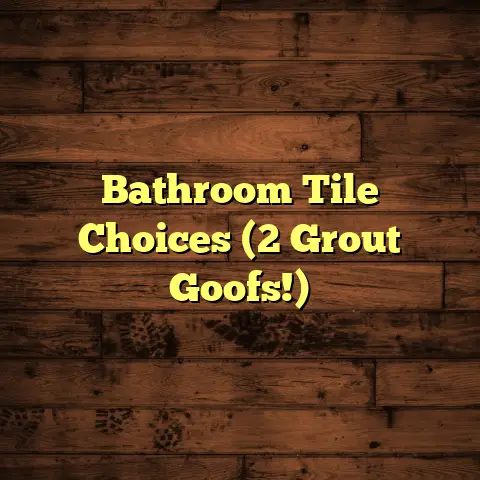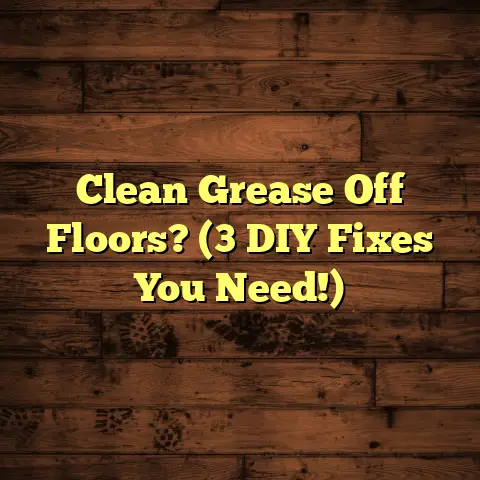Hardwood On Concrete Slab? (4 Install Blunders!)
I know I have, and for many homeowners, it’s a dream come true!
Hardwood floors aren’t just beautiful; they boost your home’s value and last for decades.
But here’s the thing: many modern homes are built with concrete slabs.
Can you install hardwood on concrete?
Absolutely!
But it’s not as simple as
slapping down some planks.
Trust me, after years in the flooring business, I’ve seen it all.
And I’m here to tell you about the four critical blunders that can turn your dream floor into a nightmare!
Avoid these, and you’ll be walking
on gorgeous hardwood for years to
come.
Let’s dive in!
The Allure of Hardwood: Why Bother?
Before we get into the nitty-gritty, let’s quickly touch on why hardwood is such a popular choice.
It’s timeless. It’s elegant. It adds character to any room.
Plus, it’s a fantastic investment.
According to the National Association
of Realtors, hardwood floors can increase
your home’s resale value by as much
as 2.5%!
But here’s the catch: that value plummets if your installation goes wrong.
And installing hardwood over concrete presents unique challenges.
Ignoring these challenges is where homeowners (and even some contractors!) run into trouble.
So, let’s get to those blunders!
Blunder #1: Inadequate Moisture Testing
This is HUGE.
Seriously, if you skip
this step, you’re basically playing
Russian roulette with your flooring.
Why is moisture such a big deal?
Concrete is porous.
It absorbs moisture
from the ground.
Even if your slab looks dry, it can be holding a surprising amount of water.
Excess moisture wreaks havoc on hardwood. It causes:
- Warping: Planks start to bend and become uneven.
- Buckling: The floor lifts and creates unsightly (and potentially dangerous) bumps.
- Mold Growth: A health hazard and a major headache to remediate.
I’ve seen floors ruined within months because the moisture levels weren’t checked.
It’s heartbreaking and completely avoidable.
How to Test for Moisture
There are several ways to test the moisture content of your concrete slab:
-
Calcium Chloride Test (The Gold Standard):
This involves placing a small container of calcium chloride on the concrete, sealing it, and measuring how much moisture the salt absorbs over a specific period (usually 72 hours).
The results tell you the moisture vapor emission rate (MVER).
This test is very accurate, but you need to ensure the floor is within the ASTM F1869 standards.
Cost: $50 – $100 per test.
Moisture Meters: These electronic devices measure the moisture content near the surface of the concrete.
They’re quicker and easier to use than the calcium chloride test, but they’re less accurate.
There are two types: * Pin Meters: Insert pins into the concrete to measure electrical resistance.
* Pinless Meters: Use electromagnetic waves to detect moisture without penetrating the surface.Cost: $50 – $500 for the meter.
-
Relative Humidity (RH) Testing:
This method involves drilling small holes in the concrete and inserting probes to measure the RH inside the slab.
It’s considered the most accurate way to assess moisture levels, as it measures the moisture deep within the concrete.
Cost: $150 – $300 per test.
Ideal Moisture Levels
So, what are the magic numbers?
It depends on the type of flooring
you’re installing, but here’s a general
guideline:
Important: Always check the flooring manufacturer’s recommendations.
They’ll specify the maximum acceptable moisture levels for their products.
The Timeline for Testing
Don’t rush this! Test before you even think about ordering your hardwood.
Ideally, test several weeks before installation to give the concrete time to dry if necessary.
If the moisture levels are too high, you’ll need to take steps to reduce them, such as using a dehumidifier or applying a moisture barrier.
Case Study: The Price of Neglect
I once worked with a homeowner who insisted his slab was “perfectly dry.”
He skipped the moisture testing and installed a beautiful oak floor.
Within six months, the floor started to buckle and warp.
The culprit? Excess moisture trapped beneath the planks.
The cost to replace the floor was over $10,000, not to mention the hassle and disruption.
Trust me, spending a few hundred dollars on moisture testing is a small price to pay compared to the cost of replacing an entire floor.
Blunder #2: Skipping the Vapor Barrier
Okay, you’ve tested for moisture, and
the levels are within the acceptable range.
Great!
But you’re not out of the woods yet.
A vapor barrier is a material that prevents moisture from migrating from the concrete slab into your hardwood floor.
Think of it as a raincoat for your flooring.
Without a vapor barrier, even if your slab has acceptable moisture levels at the time of installation, moisture can still seep up over time.
This can lead to the same problems we discussed earlier: warping, buckling, and mold growth.
Types of Vapor Barriers
There are several types of vapor barriers available:
-
Polyethylene Film: This is a thin plastic sheet that’s laid over the concrete before installing the flooring.
It’s a cost-effective option, but it can be prone to punctures and tears.
Cost: $0.10 – $0.20 per square foot.
-
Liquid-Applied Membranes: These are coatings that are applied directly to the concrete surface.
They create a seamless barrier that’s resistant to moisture and chemicals.
Cost: $1.50 – $4.00 per square foot.
-
Underlayment with Integrated Vapor Barrier: Some underlayments come with a built-in vapor barrier.
This simplifies the installation process and provides an extra layer of protection.
Cost: $0.50 – $2.00 per square foot.
Installation Process
The installation process varies depending on the type of vapor barrier you choose.
For polyethylene film, simply roll it out over the concrete, overlapping the seams by at least 6 inches and taping them securely.
For liquid-applied membranes, follow the manufacturer’s instructions carefully.
This usually involves cleaning the concrete surface, applying a primer, and then applying the membrane in multiple coats.
Expert Opinion: Don’t Skimp on
Protection
I spoke with my friend, Mark, who’s a seasoned flooring installer, about the importance of vapor barriers.
He said, “I’ve seen too many homeowners
try to save a few bucks by skipping the
vapor barrier.
It’s a huge mistake.
It’s like building a house without a roof.
It’s only a matter of time before you
have problems.”
Real-Life Disaster
A few years ago, I was called in to inspect a hardwood floor that was installed in a basement.
The homeowner had skipped the vapor barrier, and the floor was riddled with mold.
The cost to remove the mold and replace the floor was astronomical.
The homeowner ended up spending more than double what he would have spent if he had simply installed a vapor barrier in the first place.
Blunder #3: Incorrect Acclimation of
Hardwood
Acclimation is the process of allowing hardwood flooring to adjust to the temperature and humidity of the room where it will be installed.
Think of it like letting a fine wine breathe before serving it.
If you install hardwood without properly acclimating it, it can expand or contract after installation, leading to gaps, cupping, and other problems.
The Effects of Temperature and Humidity
Hardwood is a natural material, and it’s highly sensitive to changes in temperature and humidity.
When the air is humid, hardwood absorbs moisture and expands.
When the air is dry, hardwood loses moisture and contracts.
These changes in size can put stress on the flooring and cause it to warp or crack.
Acclimation Timeline and Conditions
The acclimation process typically takes several days, but it can take longer depending on the species of wood, the climate, and the moisture content of the flooring.
Here’s a general timeline:
- Solid Hardwood: 3-5 days
- Engineered Hardwood: 1-3 days
During acclimation, the flooring should be stored in the room where it will be installed, with the boxes opened to allow air to circulate.
The temperature and humidity of the room should be maintained at the levels that are expected during normal occupancy.
Ideally, the temperature should be between 60°F and 80°F, and the relative humidity should be between 30% and 50%.
Acclimation Gone Wrong
I remember one job where the homeowner was eager to get his new floor installed.
He only allowed the flooring to acclimate for one day, even though it was solid hardwood.
Within a few weeks, large gaps started to appear between the planks.
The homeowner had to pay to have the entire floor removed and reinstalled, after properly acclimating the new flooring.
Common Misconceptions
One common misconception is that acclimation is only necessary in humid climates.
While humidity does play a role, temperature fluctuations can also affect hardwood flooring.
Another misconception is that you can speed up the acclimation process by using a dehumidifier or humidifier.
While these devices can help to control the humidity of the room, it’s important to allow the flooring to acclimate naturally.
Forcing the process can actually damage the wood.
Blunder #4: Neglecting Proper
Installation Techniques
You’ve tested for moisture, installed a vapor barrier, and properly acclimated your flooring.
Congratulations! You’re almost there.
But the final step is just as important: proper installation.
There are several installation methods that are suitable for hardwood on concrete, each with its own set of pros and cons:
-
Nail-Down: This method involves nailing the hardwood planks directly to a plywood subfloor that’s been attached to the concrete.
It’s a traditional method that provides a solid, stable floor.
Pros: Feels like traditional hardwood, durable.
Cons: Requires a plywood subfloor, more labor-intensive.
-
Glue-Down: This method involves gluing the hardwood planks directly to the concrete using a special adhesive.
It’s a good option for engineered hardwood and provides a very stable floor.
Pros: Excellent stability, good for engineered wood.
Cons: Requires careful surface preparation, can be messy.
-
Floating: This method involves installing the hardwood planks over an underlayment, without attaching them to the concrete.
The planks are typically connected to each other using a tongue-and-groove system.
Pros: Easiest installation, can be installed over slightly uneven surfaces.
Cons: Can feel less solid than other methods, may have a hollow sound.
Common Installation Mistakes
No matter which installation method you choose, there are several common mistakes that can lead to problems down the road:
-
Not Preparing the Concrete Surface: The concrete surface must be clean, level, and dry before installing any type of flooring.
Any cracks or imperfections should be repaired.
-
Using the Wrong Adhesive: If you’re using the glue-down method, it’s essential to use an adhesive that’s specifically designed for hardwood flooring and concrete.
-
Not Following Manufacturer’s Instructions: Always follow the manufacturer’s instructions carefully.
They’ll provide specific guidelines for installation, including the type of adhesive to use, the spacing between planks, and the proper way to cut the flooring.
The Importance of the Right Tools
Using the right tools can make the installation process much easier and ensure a professional-looking result.
Some essential tools include:
- Moisture Meter: To check the moisture content of the concrete.
- Level: To ensure the concrete surface is level.
- Trowel: To apply adhesive evenly.
- Rubber Mallet: To tap the planks into place.
- Saw: To cut the flooring to the correct size.
Professional Insight
I recently spoke with another flooring expert, Sarah, about the impact of poor installation techniques.
She said, “I’ve seen floors that were
installed so poorly that they started
to come apart within a year.
It’s
heartbreaking for the homeowners, and
it’s a waste of good materials.”
The Long-Term Effects
Cutting corners during the installation process can have serious long-term effects.
Not only can it damage the flooring, but it can also affect the value of your home.
If you’re planning to sell your home in the future, a poorly installed floor can be a major turnoff for potential buyers.
Conclusion: Invest in Your Floor
Installing hardwood flooring on a concrete slab can be a rewarding project, but it’s essential to be aware of the potential pitfalls.
By avoiding these four common blunders, you can ensure that your new floor looks beautiful and lasts for years to come.
Remember:
- Test for moisture: Don’t skip this critical step.
- Install a vapor barrier: Protect your flooring from moisture damage.
- Acclimate properly: Allow the flooring to adjust to the temperature and humidity of the room.
- Use proper installation techniques: Follow the manufacturer’s instructions and use the right tools.
Investing in your flooring is an investment in your home.
With proper preparation, knowledge, and attention to detail, you can achieve a stunning and durable hardwood floor that you’ll enjoy for many years.
Now, go forth and create the hardwood dream you’ve always wanted!





